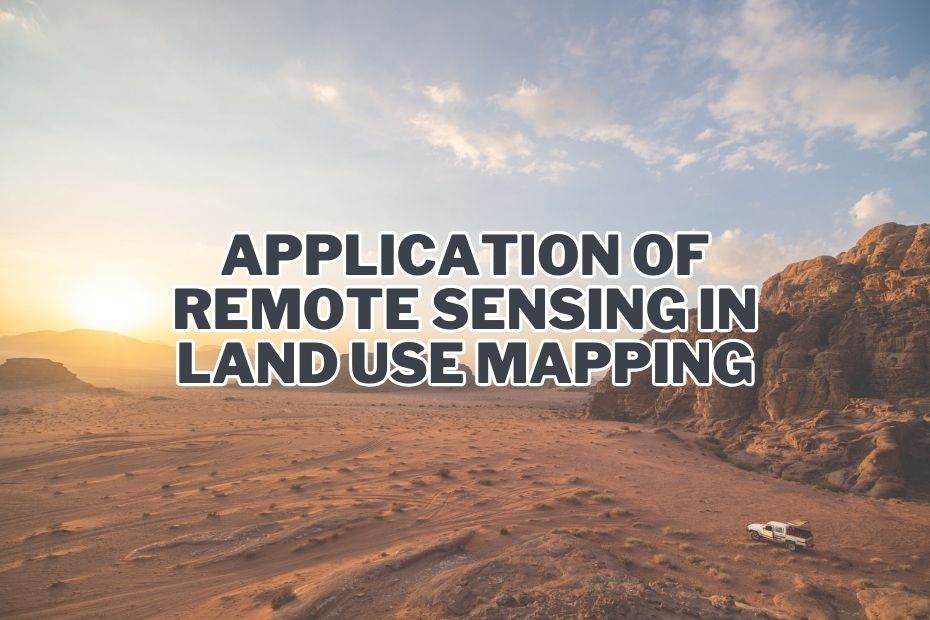With its ability to collect data from a distance, remote sensing offers invaluable insights into the Earth’s surface, enabling precise and comprehensive land use mapping for various sectors. In this article, we delve into the wide-ranging application of remote sensing in land use mapping, highlighting its role in different areas of interest.
Remote sensing plays a pivotal role in land use mapping by utilizing satellite and aerial imagery to analyze and classify different land cover types. It aids in monitoring urban development, agriculture, forestry, and environmental changes, offering invaluable insights for urban planning and natural resource management.
Exploring Application of Remote Sensing In Land Use Mapping
From city planning to environmental conservation, remote sensing is pivotal in how we understand, manage, and protect our environment. Below we explore its primary applications.
1. Urban Planning and Development
Remote sensing plays a pivotal role in urban planning and development by providing detailed spatial information essential for designing and expanding cities. Satellite imagery and aerial photographs offer planners an overview of urban areas, identifying vacant spaces, population density, and infrastructure needs. By analyzing these images, urban planners can make informed decisions to allocate resources effectively and optimize land use for residential, commercial, and industrial purposes.
2. Agricultural Monitoring
In the realm of agriculture, remote sensing contributes significantly to yield optimization and resource management. Satellite data helps monitor crop health, identify disease outbreaks, and assess soil moisture levels. By integrating remote sensing data with Geographic Information Systems (GIS), farmers can make informed decisions on irrigation, pest control, and crop rotation, leading to increased productivity and sustainable agricultural practices.
3. Forestry Management
Forests play a crucial role in maintaining ecological balance and supporting biodiversity. Remote sensing aids forestry management by providing comprehensive data on forest extent, density, and health. This information helps authorities monitor deforestation, plan reforestation initiatives, and detect forest fires in their early stages, facilitating timely intervention and conservation efforts.
4. Natural Resource Management
Remote sensing assists in the sustainable management of natural resources such as water bodies, minerals, and energy sources. By capturing data on the Earth’s surface and subsurface, remote sensing enables the identification of potential resource sites, assesses their viability, and monitors extraction activities. This technology aids in minimizing environmental impact and optimizing resource utilization.
5. Environmental Monitoring
Environmental monitoring relies heavily on remote sensing technology to track changes in ecosystems and assess the impact of human activities. From monitoring water quality and tracking pollution levels to studying land degradation and deforestation, remote sensing provides a comprehensive view of environmental changes over time, facilitating informed decision-making for conservation and mitigation strategies.
6. Disaster Management
In the realm of disaster management, remote sensing proves invaluable for assessing the extent of damage caused by natural disasters such as earthquakes, floods, and hurricanes. Satellite images and aerial surveys help authorities identify affected areas, estimate damage severity, and plan rescue and relief operations efficiently.
7. Archaeological Exploration
Archaeologists leverage remote sensing to uncover hidden archaeological sites and artifacts without disturbing the ground. Techniques such as LiDAR (Light Detection and Ranging) can reveal ancient structures and landscapes, offering new insights into historical civilizations.
8. Coastal Zone Management
Coastal zones are vulnerable to erosion, pollution, and sea-level rise. Remote sensing aids in monitoring these areas by providing data on shoreline changes, coastal erosion, and water quality. This information informs coastal management strategies and helps mitigate the impact of natural and anthropogenic changes.
9. Land Cover Change Detection
Detecting changes in land cover over time is vital for understanding urbanization, deforestation, and habitat loss. Remote sensing techniques enable the comparison of satellite images from different time periods, facilitating accurate assessment of land cover changes and their implications.
10. Mining and Mineral Exploration
Remote sensing has revolutionized the mining and mineral exploration industry by enabling the identification of potential resource-rich areas. Satellite images and hyperspectral data help geologists detect mineral deposits, map geological structures, and plan extraction activities with minimal environmental impact.
11. Wildlife Conservation
Remote sensing aids wildlife conservation efforts by tracking animal movements, habitat changes, and poaching activities. Conservationists use satellite data to monitor protected areas, assess biodiversity, and develop strategies to protect endangered species.
12. Geological Mapping
Geological surveys are crucial for understanding Earth’s composition and history. Remote sensing offers an efficient way to create geological maps by analyzing surface features, rock types, and topographic variations, assisting geologists in their research and exploration.
13. Climate Change Analysis
The impact of climate change is evident across the globe. Remote sensing provides essential data for monitoring and analyzing changes in temperature, sea ice extent, glacier melt, and more. These insights contribute to our understanding of climate trends and aid in formulating policies to address this critical issue.
Conclusion:
In conclusion, remote sensing has emerged as an indispensable tool in land use mapping, offering valuable insights across various sectors. From urban planning to climate change analysis, its applications are diverse and transformative. By harnessing the power of remote sensing technology, we can make informed decisions to ensure sustainable development and effective management of our natural resources and environment.
FAQs: Application of Remote Sensing In Land Use Mapping
How does remote sensing contribute to urban planning?
Remote sensing provides spatial information through satellite imagery, aiding urban planners in identifying vacant spaces, population density, and infrastructure needs for efficient city development.
How does remote sensing assist in wildlife conservation?
Remote sensing tracks animal movements, habitat changes, and poaching activities, enabling conservationists to monitor protected areas and develop strategies for protecting endangered species.
What is remote sensing in land use mapping?
Remote sensing in land use mapping refers to the use of satellite or aircraft-based sensor technologies to detect and classify objects on Earth, including land areas.
Is remote sensing only applicable to land-based studies?
No, its applications span across land, air, and water studies, including coastal zone management and air pollution monitoring.
